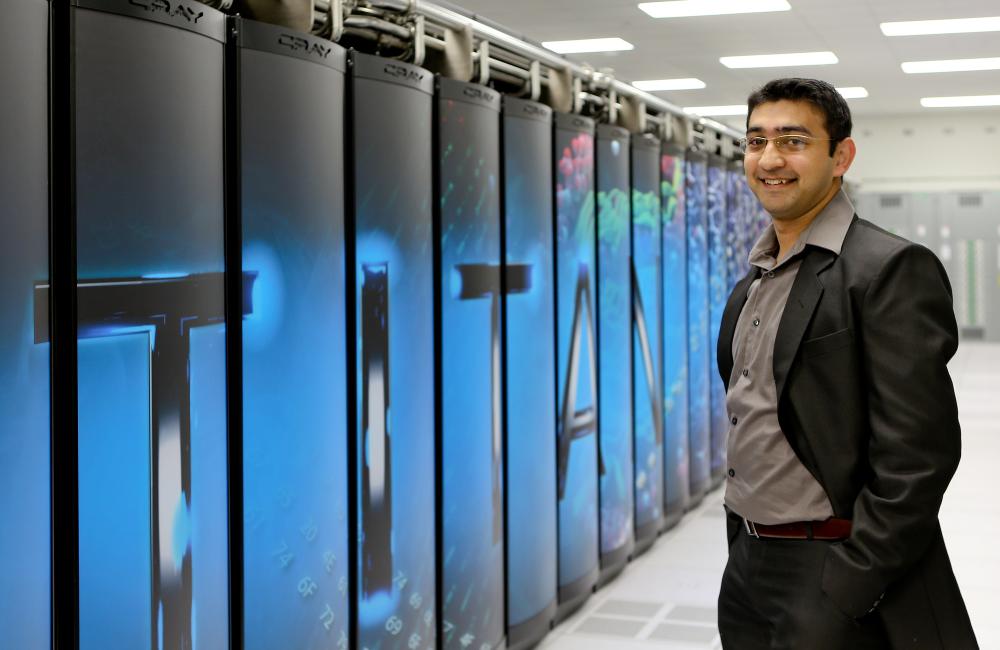August 30, 2017 – Simulating the global climate in high resolution at multiple scales will help answer questions about future global and regional climates. However, as performance expectations increase for Earth system models, so do computing challenges.
Salil Mahajan, a computational climate scientist in the Computational Earth Sciences group at the Department of Energy’s Oak Ridge National Laboratory, is tackling some of these challenges in high-performance computing for climate science.
Climate is a chaotic system. It includes complex interactions between the atmosphere, oceans, sea ice, and land. “As we include more dynamic, coupled interactions among these spheres and incorporate more biological, chemical, and physical processes in our models, the computations become more complicated. We have to take a step-by-step approach to understand cause and effect and ensure that our simulations are accurately representing our observational measurements,” explained Mahajan.
Model validation and verification are now the bread and butter of his daily routine. But Mahajan’s affinity for atmospheric science and computing architectures developed along a circuitous route.
From architecture to atmosphere
The journey began in India, where Mahajan first studied architecture of a different sort. Mahajan completed his undergraduate degree in traditional architecture. “Physics interested me, but when it came time to choose a career, I thought architecture might be a better path. I was young then, and I thought maybe I would start my own business,” he explained.
Functional architectural design appealed to him, but the aesthetic aspects did not suit his temperament. He grew dissatisfied with the inherent subjectivity of the discipline. Nevertheless, he continued to broaden his training by pursuing graduate studies in urban planning at Texas A&M University. Seeking greater objectivity, Mahajan also started exploring other career options there. After a captivating meeting with the department head for atmospheric sciences, Gerald North, Mahajan switched fields to study climate. Climate modeling and climate statistics provided an intriguing level of complexity as well as the objectivity Mahajan desired at the time.
As a graduate student, Mahajan participated in a summer internship at ORNL through the Oak Ridge Center for Advanced Studies (ORCAS). The ORCAS program paired him with Forrest Hoffman on DOE’s Atmospheric Radiation Measurement (ARM) program. Hoffman, currently a climate scientist in the Computational Sciences and Engineering Division and formerly in the Environmental Sciences Division, was using data mining techniques to compare climate data from ARM’s Lamont, Oklahoma, site with global climate model results. “The goal was to compare site observations with climate models to evaluate their performance. Model validation is an important aspect of climate research, and it continues to be a part of what I do at ORNL,” said Mahajan.
Mahajan returned to Texas A&M, completing his PhD in 2008. Afterwards he traveled to Princeton University as a post-doc and spent two years working in the Geophysical Fluid Dynamics Laboratory. That venture lined up perfectly with the emergence of the Climate Change Science Institute (CCSI) in 2009. Mahajan joined the institute in 2010 under its founding director, Jim Hack, who now directs the National Center for Computational Sciences at ORNL. Mahajan was attracted to CCSI by the lab’s reputation for computational power and cutting-edge climate research, but also out of his admiration for the researchers there, particularly, Hack. “He’s a star scientist, and I was fortunate to work with him at CCSI. We still follow his ‘visions’ of climate modeling as we move forward in our research,” said Mahajan.
Climate modeling for science and energy
Mahajan is now involved in a software modernization effort (ACME-SM) for DOE’s Accelerated Climate Modeling for Energy (ACME) project, a multi-laboratory mission to develop the most sophisticated Earth system model yet, one capable of running efficiently on leadership-class computers, with a goal to improve understanding of climate change and its future impacts on energy.
As a site-principal investigator for ACME-SM, Mahajan is applying machine learning techniques to ensure that climate model development efforts to accelerate climate model performance on the latest high-performance computers do not change model results. New hybrid computing architectures will boost climate modeling with faster processing times, but because models were designed for older architectures, upgrading involves significant code refactoring and optimization to allow the models to use high-performance systems effectively.
As computing architectures shift toward exascale and its promise of an exponential increase in computational power, computational scientists like Mahajan are busy behind the scenes making sure all the codes run properly.
UT-Battelle manages ORNL for the DOE’s Office of Science. The Office of Science is the single largest supporter of basic research in the physical sciences in the United States, and is working to address some of the most pressing challenges of our time. For more information, please visit http://energy.gov/science/.




